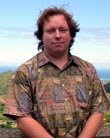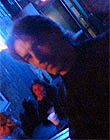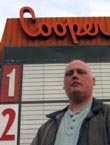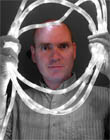|
|
This topic comprises 2 pages: 1 2
|
|
Author
|
Topic: Hobbit being filmed in at 48FPS
|
Paul Gordon
Jedi Master Film Handler
Posts: 580
From: Ottawa, Ontario, Canada
Registered: Aug 2005
|
 posted 04-13-2011 02:50 PM
posted 04-13-2011 02:50 PM





Peter Jackson has announced, via a post on his official Facebook page, that he will be shooting his adaptation of The Hobbit at the higher rate of 48 frames per second.
The usual rate is 24fps, and has been since its introduction to cinema in 1927. The Hobbit will be the first major motion picture in history to feature the upgrade
Jackson thinks, "after nine decades", it's time for a change.
In the post, he addressed the inevitable backlash from "film purists" by saying that audience will "get used to this new look very quickly" as it will bring about a "much more lifelife and comfortable viewing experience."
He also said that films will become "easier to watch, especially in 3-D", with audiences being able to sit through "two hours of footage without getting eyestrain".
Jackson went onto claim that the difference between 24 and 48 fps is "significant", likening the technological evolution to when "vinyl records were supplanted by digital CDs".
The Lord of the Rings director also thanked Warner Bros for their support in the advancement, before predicting over 10,000 screens would be capable of projecting 48fps by the time of The Hobbit's release.
Jackson, who won an Academy Award for his work on The Return of the King, took over the directing chair after Guillermo del Toro left. He had become frustrated with the constant production delays that had thwarted the project early on.
The Office's Martin Freeman has been announced to be playing Bilbo Baggins in the film, a role originally played by Sir Ian Holm in The Lord of the Rings trilogy, while Sir Ian McKellen and Andy Serkis will be reprising the characters of Gandalf and Gollum respectively.
Serkis will also act as Second Unit Director on the project.
The Hobbit will be split into two parts, with the first being released in December 2012.
from here:
http://www.totalfilm.com/news/peter-jackson-is-shooting-the-hobbit-at-48-frames-per-second?ns_campaign=news&ns_mchannel=rss&ns_source=totalfilm&ns_linkname=0&ns_fee=0&utm_source=feedburner&utm_medium=feed&utm_campaign=Feed%3A+totalfilm%2Fimdbnews+%28 Total+Film+IMDb+aggregate%29
| IP: Logged
|
|
Mark J. Marshall
Film God

Posts: 3188
From: New Castle, DE, USA
Registered: Aug 2002
|
 posted 04-13-2011 04:13 PM
posted 04-13-2011 04:13 PM



Here's the text of Jackson's post.
quote:
Time for an update. Actually, we've been intending to kick off with a video, which is almost done, so look out for that in the next day or two. In the meantime, I thought I'd address the news that has been reported about us shooting THE HOBBIT at 48 frames per second, and explain to you what my thoughts are about this.
We are indeed shooting at the higher frame rate. The key thing to understand is that this process requires both shooting and projecting at 48 fps, rather than the usual 24 fps (films have been shot at 24 frames per second since the late 1920's). So the result looks like normal speed, but the image has hugely enhanced clarity and smoothness. Looking at 24 frames every second may seem ok--and we've all seen thousands of films like this over the last 90 years--but there is often quite a lot of blur in each frame, during fast movements, and if the camera is moving around quickly, the image can judder or "strobe."
Shooting and projecting at 48 fps does a lot to get rid of these issues. It looks much more lifelike, and it is much easier to watch, especially in 3-D. We've been watching HOBBIT tests and dailies at 48 fps now for several months, and we often sit through two hours worth of footage without getting any eye strain from the 3-D. It looks great, and we've actually become used to it now, to the point that other film experiences look a little primitive. I saw a new movie in the cinema on Sunday and I kept getting distracted by the juddery panning and blurring. We're getting spoilt!
Originally, 24 fps was chosen based on the technical requirements of the early sound era. I suspect it was the minimum speed required to get some audio fidelity out of the first optical sound tracks. They would have settled on the minimum speed because of the cost of the film stock. 35mm film is expensive, and the cost per foot (to buy the negative stock, develop it and print it), has been a fairly significant part of any film budget.
So we have lived with 24 fps for 9 decades--not because it's the best film speed (it's not by any stretch), but because it was the cheapest speed to achieve basic acceptable results back in 1927 or whenever it was adopted.
None of this thinking is new. Doug Trumbull developed and promoted a 60 frames per second process called ShowScan about 30 years ago and that looked great. Unfortunately it was never adopted past theme park use. I imagine the sheer expense of burning through expensive film stock at the higher speed (you are charged per foot of film, which is about 18 frames), and the projection difficulties in cinemas, made it tough to use for "normal" films, despite looking amazing. Actually, if anybody has been on the Star Tours ride at Disneyland, you've experienced the life like quality of 60 frames per second. Our new King Kong attraction at Universal Studios also uses 60 fps.
Now that the world's cinemas are moving towards digital projection, and many films are being shot with digital cameras, increasing the frame rate becomes much easier. Most of the new digital projectors are capable of projecting at 48 fps, with only the digital servers needing some firmware upgrades. We tested both 48 fps and 60 fps. The difference between those speeds is almost impossible to detect, but the increase in quality over 24 fps is significant.
Film purists will criticize the lack of blur and strobing artifacts, but all of our crew--many of whom are film purists--are now converts. You get used to this new look very quickly and it becomes a much more lifelike and comfortable viewing experience. It's similar to the moment when vinyl records were supplanted by digital CDs. There's no doubt in my mind that we're heading towards movies being shot and projected at higher frame rates.
Warner Bros. have been very supportive, and allowed us to start shooting THE HOBBIT at 48 fps, despite there never having been a wide release feature film filmed at this higher frame rate. We are hopeful that there will be enough theaters capable of projecting 48 fps by the time The Hobbit comes out where we can seriously explore that possibility with Warner Bros. However, while it's predicted that there may be over 10,000 screens capable of projecting THE HOBBIT at 48 fps by our release date in Dec, 2012, we donít yet know what the reality will be. It is a situation we will all be monitoring carefully. I see it as a way of future-proofing THE HOBBIT. Take it from me--if we do release in 48 fps, those are the cinemas you should watch the movie in. It will look terrific!
Time to jump in the car and drive to Bag End for the day. Video coming soon!
| IP: Logged
|
|
|
|
|
|
|
|
|
|
|
|
|
|
|
|
|
|
|
|
|
|
|
|
|
|
|
|
|
|
All times are Central (GMT -6:00)
|
This topic comprises 2 pages: 1 2
|
Powered by Infopop Corporation
UBB.classicTM
6.3.1.2
The Film-Tech Forums are designed for various members related to the cinema industry to express their opinions, viewpoints and testimonials on various products, services and events based upon speculation, personal knowledge and factual information through use, therefore all views represented here allow no liability upon the publishers of this web site and the owners of said views assume no liability for any ill will resulting from these postings. The posts made here are for educational as well as entertainment purposes and as such anyone viewing this portion of the website must accept these views as statements of the author of that opinion
and agrees to release the authors from any and all liability.
|

 Home
Home
 Products
Products
 Store
Store
 Forum
Forum
 Warehouse
Warehouse
 Contact Us
Contact Us




 Printer-friendly view of this topic
Printer-friendly view of this topic
















